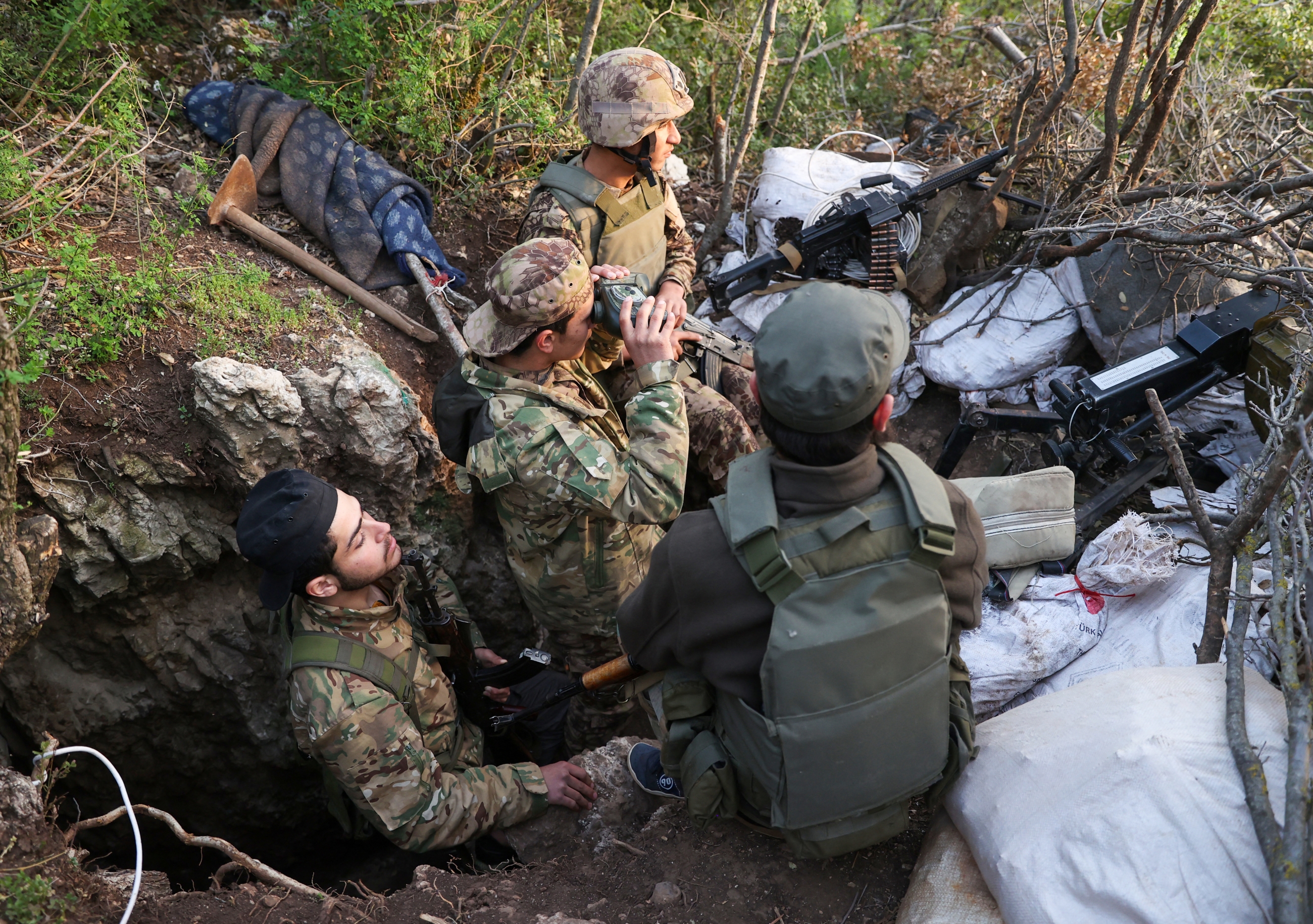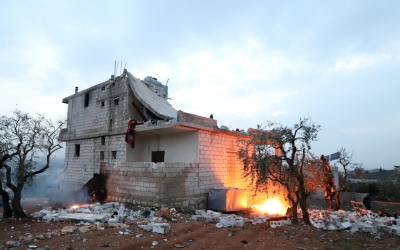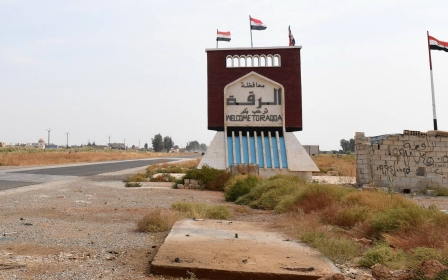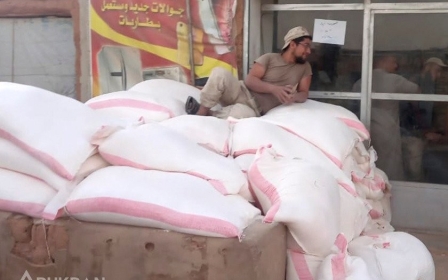Syria's rebel divisions laid bare as HTS takes Afrin villages from Turkish-backed groups

Militant group Hay'at Tahrir al-Sham (HTS) has captured a number of villages belonging to Turkish-backed fighters in northern Syria as tensions, disagreement and conflict between rebel groups continue to rage.
The group, a former al-Qaeda affiliate that rules much of northwestern Syria, took control of the villages of Basufan, Qabasin and Fafertin in the southern Afrin region on Saturday night and sent military reinforcements on Tuesday, according to military sources.
'There were hundreds of civilians stuck at the crossings, and the escalation of clashes meant heavy casualties, so we allowed the convoys to enter Deir Ballut crossing'
- Faylaq al-Sham leader
Sources told Middle East Eye that the Turkish-backed Syrian National Army (SNA) sent in more troops to reinforce their fortifications in Afrin, and held a meeting with HTS under Turkish auspices in the town of Atme, north of Idlib.
A Turkish helicopter landed near a military border crossing leading to Atme. Hours later, the negotiators agreed on the withdrawal of HTS from the villages it had captured, but nothing changed on the ground.
Meanwhile, civilians and SNA supporters gathered in the city of Afrin and warned against HTS entering their areas.
New MEE newsletter: Jerusalem Dispatch
Sign up to get the latest insights and analysis on Israel-Palestine, alongside Turkey Unpacked and other MEE newsletters
The incident has once again highlighted the widespread divisions that exist between the different Syrian opposition groups, a factor which some have pointed to as the defining reason for the rebels' loss in the Syrian civil war.
Northwestern Syria is the last part of the country that is still held by forces nominally dedicated to the overthrow of Syrian President Bashar al-Assad, who has retaken most former rebel territories since the war began in 2011.
However, control of rebel areas is now largely split between the SNA, which is supported by Turkey, and HTS.
Turkey has launched a series of operations in northern Syria that have mainly been aimed at undercutting the People's Protection Units (YPG), a pro-Kurdish organisation that Turkey regards as a terrorist group linked to the Kurdistan Workers' Party (PKK).
Major defeat
Since 2015, HTS - formerly comprising the al-Qaeda-affiliated Al-Nusra Front - has expanded its influence across Idlib, in northwestern Syria. By 2019, it effectively controlled the entire governorate.
Much of its success has stemmed from deploying divide and rule tactics against fellow rebel groups.
In 2017, HTS split from al-Qaeda and then turned against another powerful rebel group, Ahrar al-Sham, on the pretext that Ahrar al-Sham was planning to facilitate the entry of the Turkish army into Idlib.
This led Ahrar al-Sham to split into two parts, one bowing to HTS and the other dispersing after expelling their leaders to northern Aleppo.
Local activists initially denied that HTS had entered Afrin over the weekend because allowing HTS - which did not explicitly declare its takeover of any village - to advance without much pushback would indicate a major defeat for the SNA.
The areas captured by HTS are highly strategic because they are adjacent to the city of Tal Rifaat, which is controlled by the Syrian Democratic Forces (SDF), a US-backed group of Kurdish and Arab fighters dominated by the YPG.
Faylaq al-Sham, one of the groups comprising the Turkish-backed SNA, denied in a statement that it had abandoned the areas without fighting, or that it had facilitated the entry of HTS.
A three-page statement from the group, seen by MEE, said that Faylaq al-Sham was not able to repel the progress of HTS alone, and that other factions of the SNA had failed to support them.
They said HTS attacked with around 700 vehicles, and that Faylaq al-Sham tried to stop them by closing the al-Ghazawiya and Deir Ballut crossings, which separate the Idlib area under the control of HTS and areas north of Aleppo under the control of the Syrian National Army.
“There were hundreds of civilians stuck at the crossings, and the escalation of clashes meant heavy casualties, so we allowed the convoys to enter Deir Ballut crossing,” a leader from Faylaq al-Sham told MEE.
“Their main goal is to spread in the areas adjacent to the SDF and open a commercial crossing and smuggling routes with them,” he added of HTS, saying they had detected nocturnal movements and previous smuggling operations by the militant group from these areas.
'Unjustly attacked'
HTS have denied they were motivated by smuggling.
Speaking to MEE, a leader in the group said its main aim was to support Ahrar al-Sham against one of HTS' longtime rivals, Jaish al-Islam.
“They are small and weak groups, which were unjustly attacked at the instigation of Jaish al-Islam and the Levant Front on the pretext that they belong to us,” the HTS leader claimed.
However, he confirmed that the group's forces took control of areas in Afrin after entering it in the name of Ahrar al-Sham.
'[Ahrar al-Sham] are small and weak groups, which were unjustly attacked at the instigation of Jaish al-Islam and the Levant Front on the pretext that they belong to us'
- HTS leader
Ahrar al-Sham's anti-HTS wing is known as the Eastern Sector.
After splitting from the leaders of Ahrar al-Sham in Idlib, it worked under the name of the 23rd Division and united with Jaish al-Islam, the Levant Front and other factions under the name 3rd Corps. This grouping is one of the main components of the SNA.
A very complex dispute between Ahrar al-Sham and the Levant Front has escalated in recent months, after leaders of the 3rd Corps dismissed the commanders of the 23rd Division, accusing them of being loyal to HTS.
The 23rd Division rejected this, defecting from the 3rd Corps and joining the Thaeron movement, a grouping of some other factions of the SNA.
This latter unit did not last long and the 23rd Division defected again, then finally announced that it was joining the leadership of Ahrar al-Sham in Idlib.
The 3rd Corps said they considered the matter an internal rebellion, and on Saturday launched a tank attack to seize the headquarters of the 23rd Division, in the city of al-Bab, killing about 23 people, including civilians.
The 3rd Corps said in a statement that this decision had been reached by a local dispute resolution committee, which was run by a sheikh affiliated with Faylaq al-Sham and linked to Sheikh Osama al-Rifai, the opposition Mufti of Syria and the head of Turkey-based Syrian Islamic Council.
The Islamic Council issued a statement calling for adherence to the committee's decisions and to confront the progress of HTS.
Failed deals
Over a period of months, controversial rumours about the entry of columns from HTS or Ahrar al-Sham to support the 23rd Division have circulated in southern Afrin.
The two groups are based about 160km from each other, with the main headquarters of the SNA groups in the middle.
Nevertheless, large military columns and crowds supporting HTS moved in to the southern Afrin villages on Saturday under the banner of Ahrar al-Sham and raised their flags, taking control of large areas south of Afrin city.
The next day, a deal was reached between all parties that the 23rd Division would restore its headquarters in the city of Al-Bab, and that the SNA would recover large areas lost in Afrin.
Following this, the sides began to withdraw, and the 23rd Division regained its headquarters.
However, HTS has not handed over all the areas it captured, and maintains control of the three villages.
The Syrian conflict has killed about 350,000 people and displaced about 13 million Syrians from their homes, according to the United Nations.
Middle East Eye delivers independent and unrivalled coverage and analysis of the Middle East, North Africa and beyond. To learn more about republishing this content and the associated fees, please fill out this form. More about MEE can be found here.





